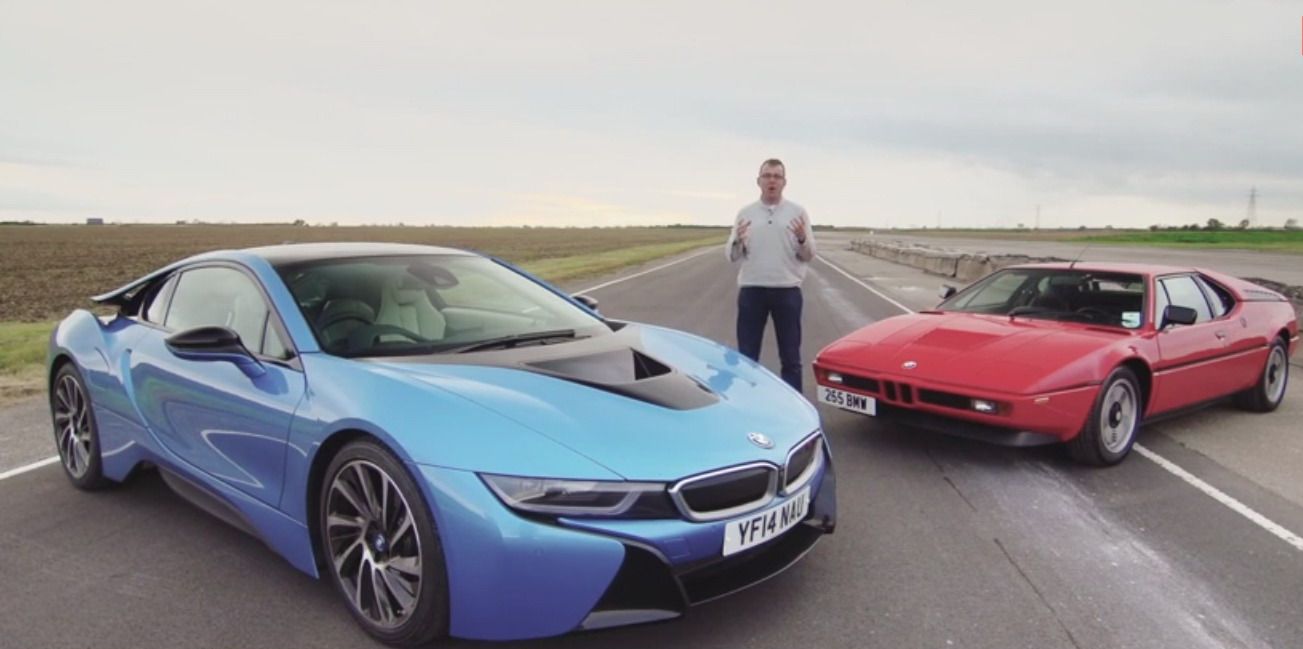Although BMW->ke178 had a hard time selling it in its era, the M1 turned out to be one of the company's most sought-after classic cars->ke503. And even though it was legendary for being BMW's only production, mid-engine sports car->ke506, the M1 has yet to receive an official successor. As far as most enthusiasts are concerned, however, the brand-new i8 is the perfect modern-day M1. It has sports car proportions, aggressive styling, and although it features a hybrid->ke147 drivetrain, the gasoline engine is mounted behind the seats.
Although I'm not particularly excited about calling the i8 the spiritual successor to the M1, I must confess I've always wanted to see the two in a head-to-head comparison. If you're like me, than this is your lucky day, as the folks over at Auto Express brought the two sports cars together for a track battle. Sure, the M1 and the i8 were launched 35 years apart, sharing only the BMW badge and a mid-engine layout. While the M1 was developed as a homologation special for racing->ke447 and became a revered classic only decades later, the i8 is BMW's way of showcasing its latest technologies and advanced hybrid drivetrain.
And that's exactly what makes this video a captivating comparison, one in which the old meets the new and the race-bred classic encounters the vehicle that represents BMW's future.
BMW i8
Introduced for the 2015 model year, the i8 is BMW's first mid-engine sports car since 1981, when the iconic M1 was discontinued. Its exterior design is based on the Vision Efficient Dynamics concept's, while extensive use of aluminum and carbon-reinforced plastic (CFRP) for the chassis and the passenger cell make it tip the scales at less than 3,285 pounds. The interior sports an equally modern layout that blends sportiness and luxury.
The i8 is motivated by a 1.5-liter, three-cylinder engine that sends 231 horsepower and 236 pound-feet of torque to the rear wheels. An electric motor that produces 131 horsepower and 184 pound-feet of torque spins the front wheels. Combined, the driveline generates 362 horsepower and 420 pound-feet of twist and uses a six-speed automatic transmission for the gasoline engine and a two-stage transmission for the electric motor.
The German sports car needs 4.2 seconds to charge from 0 to 60 mph on its way to a top speed of 155 mph. The i8 retails from $135,925 including destination and handling fees.
BMW M1
The history of the M1 began when BMW signed an agreement with Italian manufacturer Lamborghini to build a mid-engine sports car in sufficient quantity for racing homologation. The collaboration didn’t go as planned, and BMW eventually decided to produce the car itself with input from its already famous Motorsport division. The M1 went on sale in 1978 with a very Italian body designed by Giugiaro and built by Baur. Only 453 examples were built, making the M1 one of BMW’s rarest models.
The M1 got its juice from a twin-cam, 3.5-liter, inline-six engine mounted behind the seats. The six-banger cranked out 273 horsepower and 243 pound-feet of torque, and used a ZF, five-speed manual gearbox to route the oomph to the rear wheels. The M1 needed about 6.5 seconds to hit 60 mph from a standing start, while its top speed was rated at 164 mph. Both impressive figures for the era.
The M1 was the most expensive BMW at launch and due to its rarity and appeal, it is also the most expensive road-legal BMW today, with mint examples fetching more than $400,000 at auctions.

